Critical Analysis of Leadership Styles in Business Organizations
VerifiedAdded on 2020/03/16
|14
|4998
|457
Report
AI Summary
This report provides a critical analysis of the leadership styles of three successful business leaders: David Rohrsheim, Daniel Flynn, and Naomi Simson. It begins with an introduction that emphasizes the importance of leadership in today's competitive market and the evolving nature of leadership theories. The discussion section delves into the backgrounds, roles, achievements, and leadership traits of each leader, highlighting their unique strategies and approaches to handling challenges. David Rohrsheim's role in Uber's Australian division, Daniel Flynn's entrepreneurial efforts with Thankyou, and Naomi Simson's success with RedBalloon are examined, including their contributions to their respective organizations. The report also contrasts the leaders' styles, analyzes their approaches, and relates their practices to various leadership theories. A recommendation section suggests ways to maintain the success factors of these leaders, followed by a conclusion that summarizes the connection between theory and practice. The report emphasizes the impact of leadership on organizational success and the importance of adapting leadership styles to meet changing market demands.

qwertyuiopasdfghjklzxcvbnmqwertyui
opasdfghjklzxcvbnmqwertyuiopasdfgh
jklzxcvbnmqwertyuiopasdfghjklzxcvb
nmqwertyuiopasdfghjklzxcvbnmqwer
tyuiopasdfghjklzxcvbnmqwertyuiopas
dfghjklzxcvbnmqwertyuiopasdfghjklzx
cvbnmqwertyuiopasdfghjklzxcvbnmq
wertyuiopasdfghjklzxcvbnmqwertyuio
pasdfghjklzxcvbnmqwertyuiopasdfghj
klzxcvbnmqwertyuiopasdfghjklzxcvbn
mqwertyuiopasdfghjklzxcvbnmqwerty
uiopasdfghjklzxcvbnmqwertyuiopasdf
Leadership
opasdfghjklzxcvbnmqwertyuiopasdfgh
jklzxcvbnmqwertyuiopasdfghjklzxcvb
nmqwertyuiopasdfghjklzxcvbnmqwer
tyuiopasdfghjklzxcvbnmqwertyuiopas
dfghjklzxcvbnmqwertyuiopasdfghjklzx
cvbnmqwertyuiopasdfghjklzxcvbnmq
wertyuiopasdfghjklzxcvbnmqwertyuio
pasdfghjklzxcvbnmqwertyuiopasdfghj
klzxcvbnmqwertyuiopasdfghjklzxcvbn
mqwertyuiopasdfghjklzxcvbnmqwerty
uiopasdfghjklzxcvbnmqwertyuiopasdf
Leadership
Paraphrase This Document
Need a fresh take? Get an instant paraphrase of this document with our AI Paraphraser
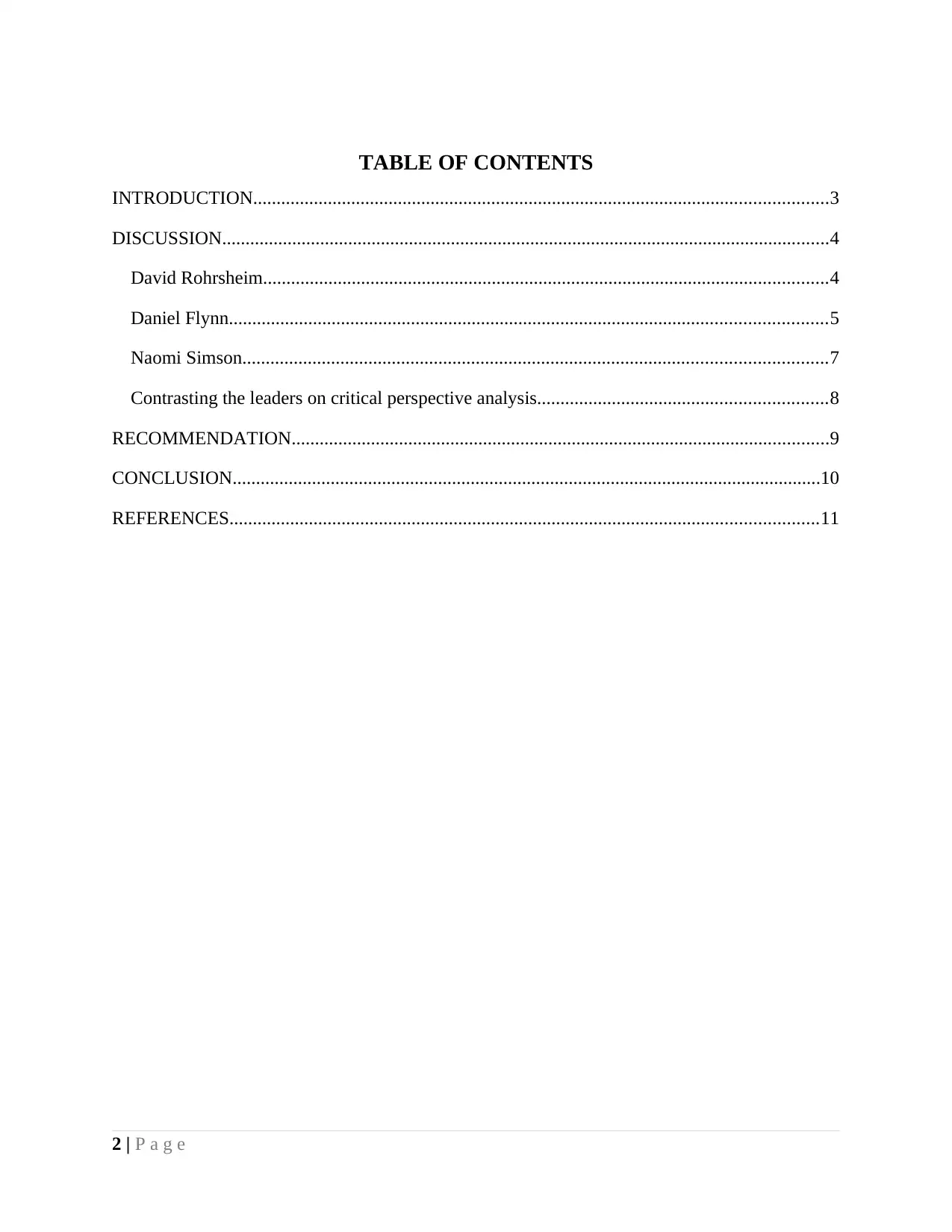
TABLE OF CONTENTS
INTRODUCTION...........................................................................................................................3
DISCUSSION..................................................................................................................................4
David Rohrsheim.........................................................................................................................4
Daniel Flynn................................................................................................................................5
Naomi Simson.............................................................................................................................7
Contrasting the leaders on critical perspective analysis..............................................................8
RECOMMENDATION...................................................................................................................9
CONCLUSION..............................................................................................................................10
REFERENCES..............................................................................................................................11
2 | P a g e
INTRODUCTION...........................................................................................................................3
DISCUSSION..................................................................................................................................4
David Rohrsheim.........................................................................................................................4
Daniel Flynn................................................................................................................................5
Naomi Simson.............................................................................................................................7
Contrasting the leaders on critical perspective analysis..............................................................8
RECOMMENDATION...................................................................................................................9
CONCLUSION..............................................................................................................................10
REFERENCES..............................................................................................................................11
2 | P a g e
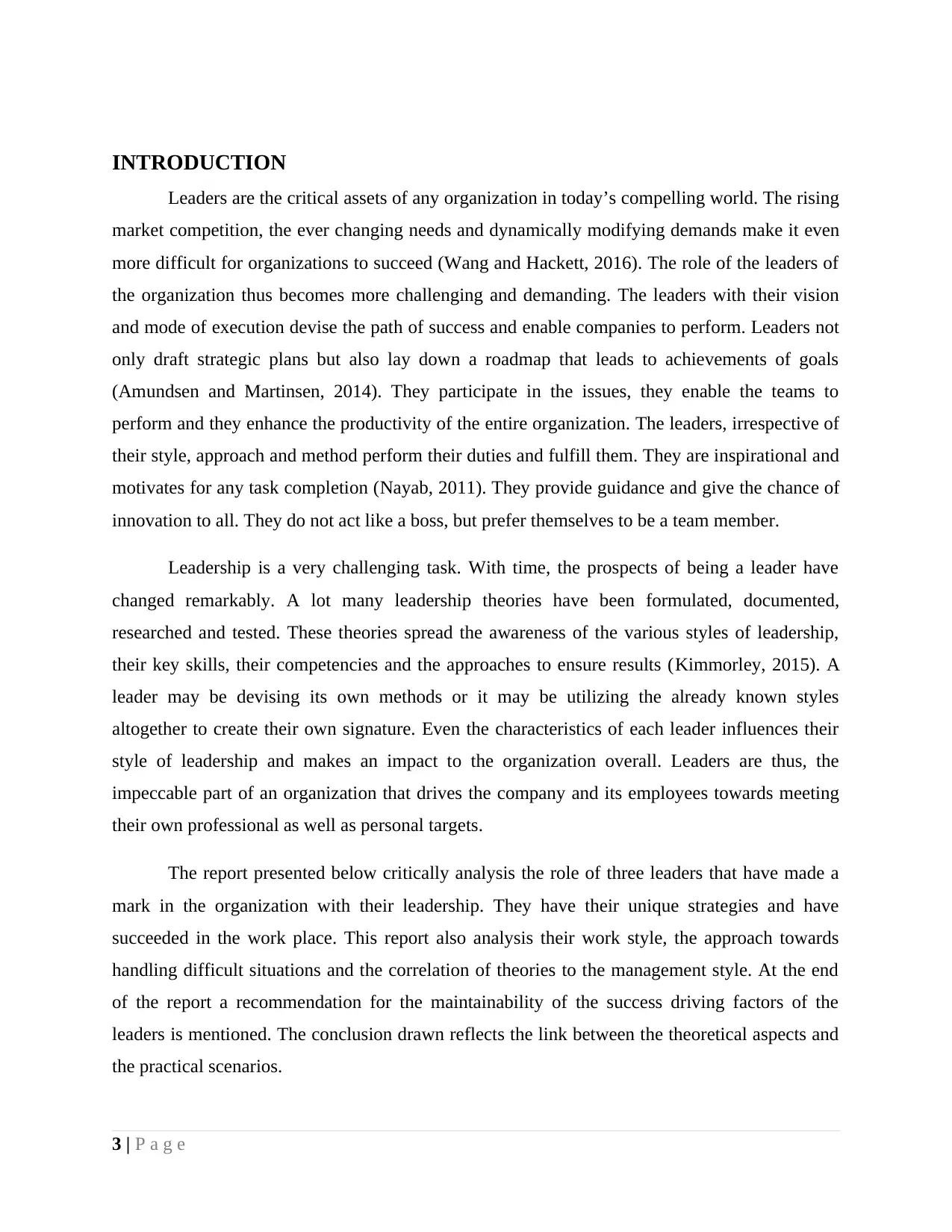
INTRODUCTION
Leaders are the critical assets of any organization in today’s compelling world. The rising
market competition, the ever changing needs and dynamically modifying demands make it even
more difficult for organizations to succeed (Wang and Hackett, 2016). The role of the leaders of
the organization thus becomes more challenging and demanding. The leaders with their vision
and mode of execution devise the path of success and enable companies to perform. Leaders not
only draft strategic plans but also lay down a roadmap that leads to achievements of goals
(Amundsen and Martinsen, 2014). They participate in the issues, they enable the teams to
perform and they enhance the productivity of the entire organization. The leaders, irrespective of
their style, approach and method perform their duties and fulfill them. They are inspirational and
motivates for any task completion (Nayab, 2011). They provide guidance and give the chance of
innovation to all. They do not act like a boss, but prefer themselves to be a team member.
Leadership is a very challenging task. With time, the prospects of being a leader have
changed remarkably. A lot many leadership theories have been formulated, documented,
researched and tested. These theories spread the awareness of the various styles of leadership,
their key skills, their competencies and the approaches to ensure results (Kimmorley, 2015). A
leader may be devising its own methods or it may be utilizing the already known styles
altogether to create their own signature. Even the characteristics of each leader influences their
style of leadership and makes an impact to the organization overall. Leaders are thus, the
impeccable part of an organization that drives the company and its employees towards meeting
their own professional as well as personal targets.
The report presented below critically analysis the role of three leaders that have made a
mark in the organization with their leadership. They have their unique strategies and have
succeeded in the work place. This report also analysis their work style, the approach towards
handling difficult situations and the correlation of theories to the management style. At the end
of the report a recommendation for the maintainability of the success driving factors of the
leaders is mentioned. The conclusion drawn reflects the link between the theoretical aspects and
the practical scenarios.
3 | P a g e
Leaders are the critical assets of any organization in today’s compelling world. The rising
market competition, the ever changing needs and dynamically modifying demands make it even
more difficult for organizations to succeed (Wang and Hackett, 2016). The role of the leaders of
the organization thus becomes more challenging and demanding. The leaders with their vision
and mode of execution devise the path of success and enable companies to perform. Leaders not
only draft strategic plans but also lay down a roadmap that leads to achievements of goals
(Amundsen and Martinsen, 2014). They participate in the issues, they enable the teams to
perform and they enhance the productivity of the entire organization. The leaders, irrespective of
their style, approach and method perform their duties and fulfill them. They are inspirational and
motivates for any task completion (Nayab, 2011). They provide guidance and give the chance of
innovation to all. They do not act like a boss, but prefer themselves to be a team member.
Leadership is a very challenging task. With time, the prospects of being a leader have
changed remarkably. A lot many leadership theories have been formulated, documented,
researched and tested. These theories spread the awareness of the various styles of leadership,
their key skills, their competencies and the approaches to ensure results (Kimmorley, 2015). A
leader may be devising its own methods or it may be utilizing the already known styles
altogether to create their own signature. Even the characteristics of each leader influences their
style of leadership and makes an impact to the organization overall. Leaders are thus, the
impeccable part of an organization that drives the company and its employees towards meeting
their own professional as well as personal targets.
The report presented below critically analysis the role of three leaders that have made a
mark in the organization with their leadership. They have their unique strategies and have
succeeded in the work place. This report also analysis their work style, the approach towards
handling difficult situations and the correlation of theories to the management style. At the end
of the report a recommendation for the maintainability of the success driving factors of the
leaders is mentioned. The conclusion drawn reflects the link between the theoretical aspects and
the practical scenarios.
3 | P a g e
⊘ This is a preview!⊘
Do you want full access?
Subscribe today to unlock all pages.

Trusted by 1+ million students worldwide
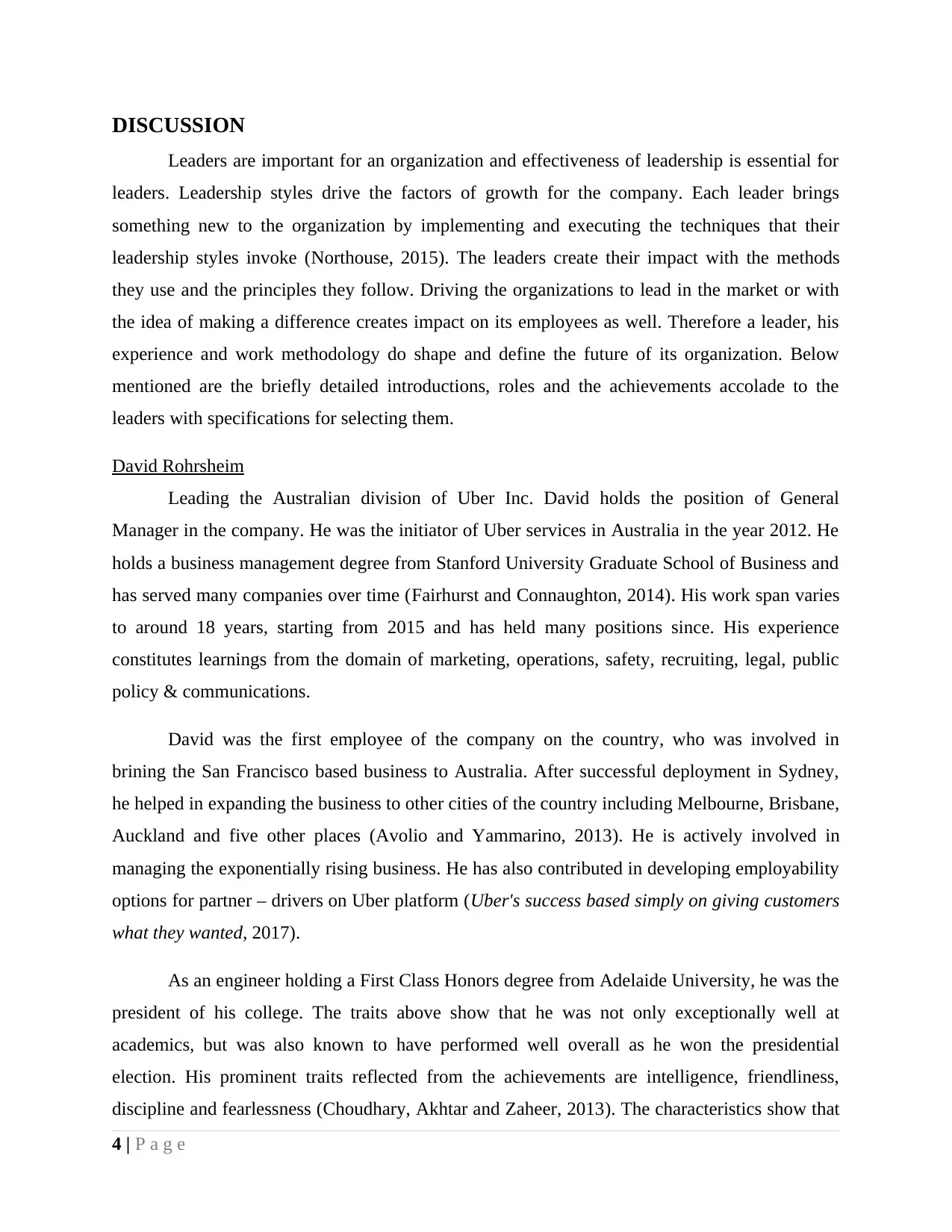
DISCUSSION
Leaders are important for an organization and effectiveness of leadership is essential for
leaders. Leadership styles drive the factors of growth for the company. Each leader brings
something new to the organization by implementing and executing the techniques that their
leadership styles invoke (Northouse, 2015). The leaders create their impact with the methods
they use and the principles they follow. Driving the organizations to lead in the market or with
the idea of making a difference creates impact on its employees as well. Therefore a leader, his
experience and work methodology do shape and define the future of its organization. Below
mentioned are the briefly detailed introductions, roles and the achievements accolade to the
leaders with specifications for selecting them.
David Rohrsheim
Leading the Australian division of Uber Inc. David holds the position of General
Manager in the company. He was the initiator of Uber services in Australia in the year 2012. He
holds a business management degree from Stanford University Graduate School of Business and
has served many companies over time (Fairhurst and Connaughton, 2014). His work span varies
to around 18 years, starting from 2015 and has held many positions since. His experience
constitutes learnings from the domain of marketing, operations, safety, recruiting, legal, public
policy & communications.
David was the first employee of the company on the country, who was involved in
brining the San Francisco based business to Australia. After successful deployment in Sydney,
he helped in expanding the business to other cities of the country including Melbourne, Brisbane,
Auckland and five other places (Avolio and Yammarino, 2013). He is actively involved in
managing the exponentially rising business. He has also contributed in developing employability
options for partner – drivers on Uber platform (Uber's success based simply on giving customers
what they wanted, 2017).
As an engineer holding a First Class Honors degree from Adelaide University, he was the
president of his college. The traits above show that he was not only exceptionally well at
academics, but was also known to have performed well overall as he won the presidential
election. His prominent traits reflected from the achievements are intelligence, friendliness,
discipline and fearlessness (Choudhary, Akhtar and Zaheer, 2013). The characteristics show that
4 | P a g e
Leaders are important for an organization and effectiveness of leadership is essential for
leaders. Leadership styles drive the factors of growth for the company. Each leader brings
something new to the organization by implementing and executing the techniques that their
leadership styles invoke (Northouse, 2015). The leaders create their impact with the methods
they use and the principles they follow. Driving the organizations to lead in the market or with
the idea of making a difference creates impact on its employees as well. Therefore a leader, his
experience and work methodology do shape and define the future of its organization. Below
mentioned are the briefly detailed introductions, roles and the achievements accolade to the
leaders with specifications for selecting them.
David Rohrsheim
Leading the Australian division of Uber Inc. David holds the position of General
Manager in the company. He was the initiator of Uber services in Australia in the year 2012. He
holds a business management degree from Stanford University Graduate School of Business and
has served many companies over time (Fairhurst and Connaughton, 2014). His work span varies
to around 18 years, starting from 2015 and has held many positions since. His experience
constitutes learnings from the domain of marketing, operations, safety, recruiting, legal, public
policy & communications.
David was the first employee of the company on the country, who was involved in
brining the San Francisco based business to Australia. After successful deployment in Sydney,
he helped in expanding the business to other cities of the country including Melbourne, Brisbane,
Auckland and five other places (Avolio and Yammarino, 2013). He is actively involved in
managing the exponentially rising business. He has also contributed in developing employability
options for partner – drivers on Uber platform (Uber's success based simply on giving customers
what they wanted, 2017).
As an engineer holding a First Class Honors degree from Adelaide University, he was the
president of his college. The traits above show that he was not only exceptionally well at
academics, but was also known to have performed well overall as he won the presidential
election. His prominent traits reflected from the achievements are intelligence, friendliness,
discipline and fearlessness (Choudhary, Akhtar and Zaheer, 2013). The characteristics show that
4 | P a g e
Paraphrase This Document
Need a fresh take? Get an instant paraphrase of this document with our AI Paraphraser
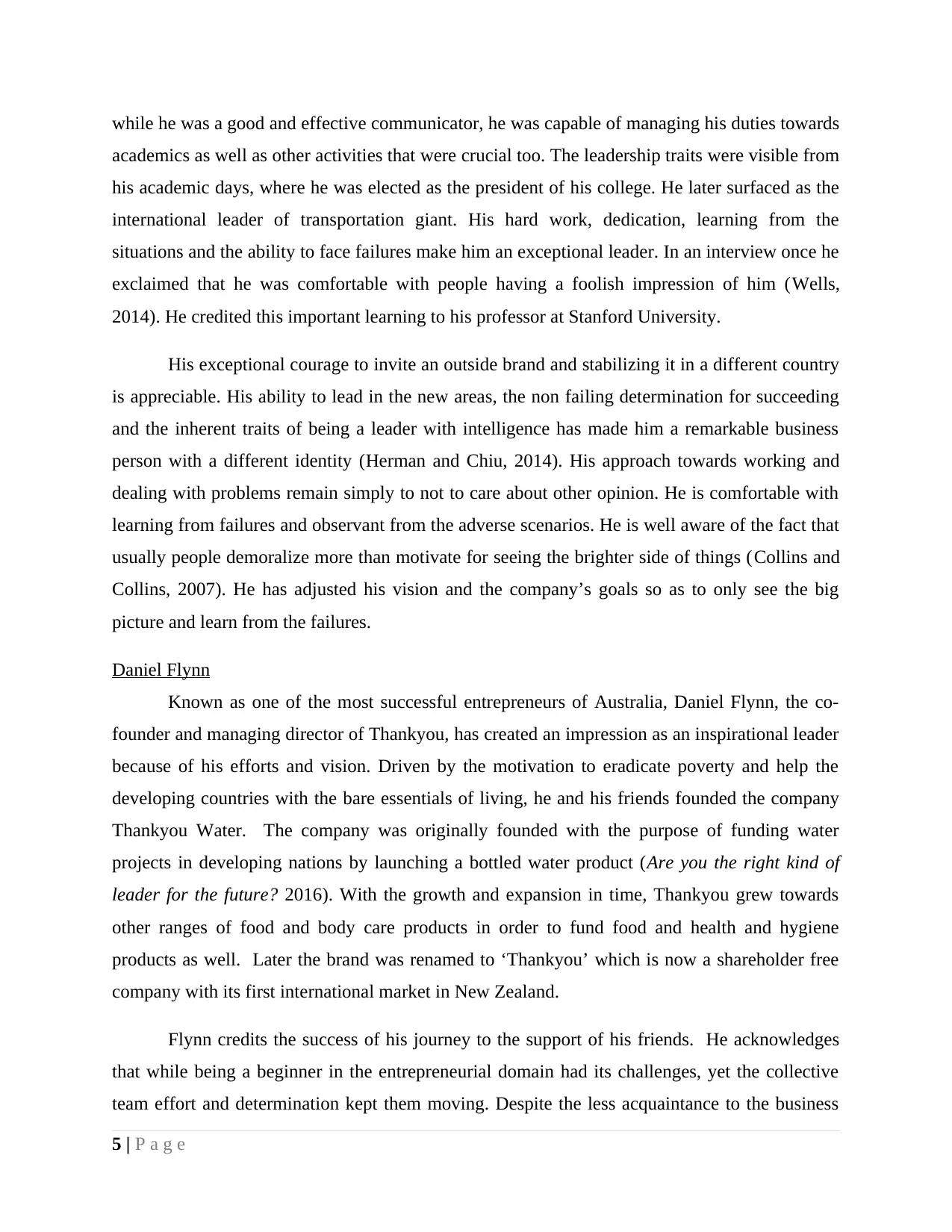
while he was a good and effective communicator, he was capable of managing his duties towards
academics as well as other activities that were crucial too. The leadership traits were visible from
his academic days, where he was elected as the president of his college. He later surfaced as the
international leader of transportation giant. His hard work, dedication, learning from the
situations and the ability to face failures make him an exceptional leader. In an interview once he
exclaimed that he was comfortable with people having a foolish impression of him (Wells,
2014). He credited this important learning to his professor at Stanford University.
His exceptional courage to invite an outside brand and stabilizing it in a different country
is appreciable. His ability to lead in the new areas, the non failing determination for succeeding
and the inherent traits of being a leader with intelligence has made him a remarkable business
person with a different identity (Herman and Chiu, 2014). His approach towards working and
dealing with problems remain simply to not to care about other opinion. He is comfortable with
learning from failures and observant from the adverse scenarios. He is well aware of the fact that
usually people demoralize more than motivate for seeing the brighter side of things (Collins and
Collins, 2007). He has adjusted his vision and the company’s goals so as to only see the big
picture and learn from the failures.
Daniel Flynn
Known as one of the most successful entrepreneurs of Australia, Daniel Flynn, the co-
founder and managing director of Thankyou, has created an impression as an inspirational leader
because of his efforts and vision. Driven by the motivation to eradicate poverty and help the
developing countries with the bare essentials of living, he and his friends founded the company
Thankyou Water. The company was originally founded with the purpose of funding water
projects in developing nations by launching a bottled water product (Are you the right kind of
leader for the future? 2016). With the growth and expansion in time, Thankyou grew towards
other ranges of food and body care products in order to fund food and health and hygiene
products as well. Later the brand was renamed to ‘Thankyou’ which is now a shareholder free
company with its first international market in New Zealand.
Flynn credits the success of his journey to the support of his friends. He acknowledges
that while being a beginner in the entrepreneurial domain had its challenges, yet the collective
team effort and determination kept them moving. Despite the less acquaintance to the business
5 | P a g e
academics as well as other activities that were crucial too. The leadership traits were visible from
his academic days, where he was elected as the president of his college. He later surfaced as the
international leader of transportation giant. His hard work, dedication, learning from the
situations and the ability to face failures make him an exceptional leader. In an interview once he
exclaimed that he was comfortable with people having a foolish impression of him (Wells,
2014). He credited this important learning to his professor at Stanford University.
His exceptional courage to invite an outside brand and stabilizing it in a different country
is appreciable. His ability to lead in the new areas, the non failing determination for succeeding
and the inherent traits of being a leader with intelligence has made him a remarkable business
person with a different identity (Herman and Chiu, 2014). His approach towards working and
dealing with problems remain simply to not to care about other opinion. He is comfortable with
learning from failures and observant from the adverse scenarios. He is well aware of the fact that
usually people demoralize more than motivate for seeing the brighter side of things (Collins and
Collins, 2007). He has adjusted his vision and the company’s goals so as to only see the big
picture and learn from the failures.
Daniel Flynn
Known as one of the most successful entrepreneurs of Australia, Daniel Flynn, the co-
founder and managing director of Thankyou, has created an impression as an inspirational leader
because of his efforts and vision. Driven by the motivation to eradicate poverty and help the
developing countries with the bare essentials of living, he and his friends founded the company
Thankyou Water. The company was originally founded with the purpose of funding water
projects in developing nations by launching a bottled water product (Are you the right kind of
leader for the future? 2016). With the growth and expansion in time, Thankyou grew towards
other ranges of food and body care products in order to fund food and health and hygiene
products as well. Later the brand was renamed to ‘Thankyou’ which is now a shareholder free
company with its first international market in New Zealand.
Flynn credits the success of his journey to the support of his friends. He acknowledges
that while being a beginner in the entrepreneurial domain had its challenges, yet the collective
team effort and determination kept them moving. Despite the less acquaintance to the business
5 | P a g e
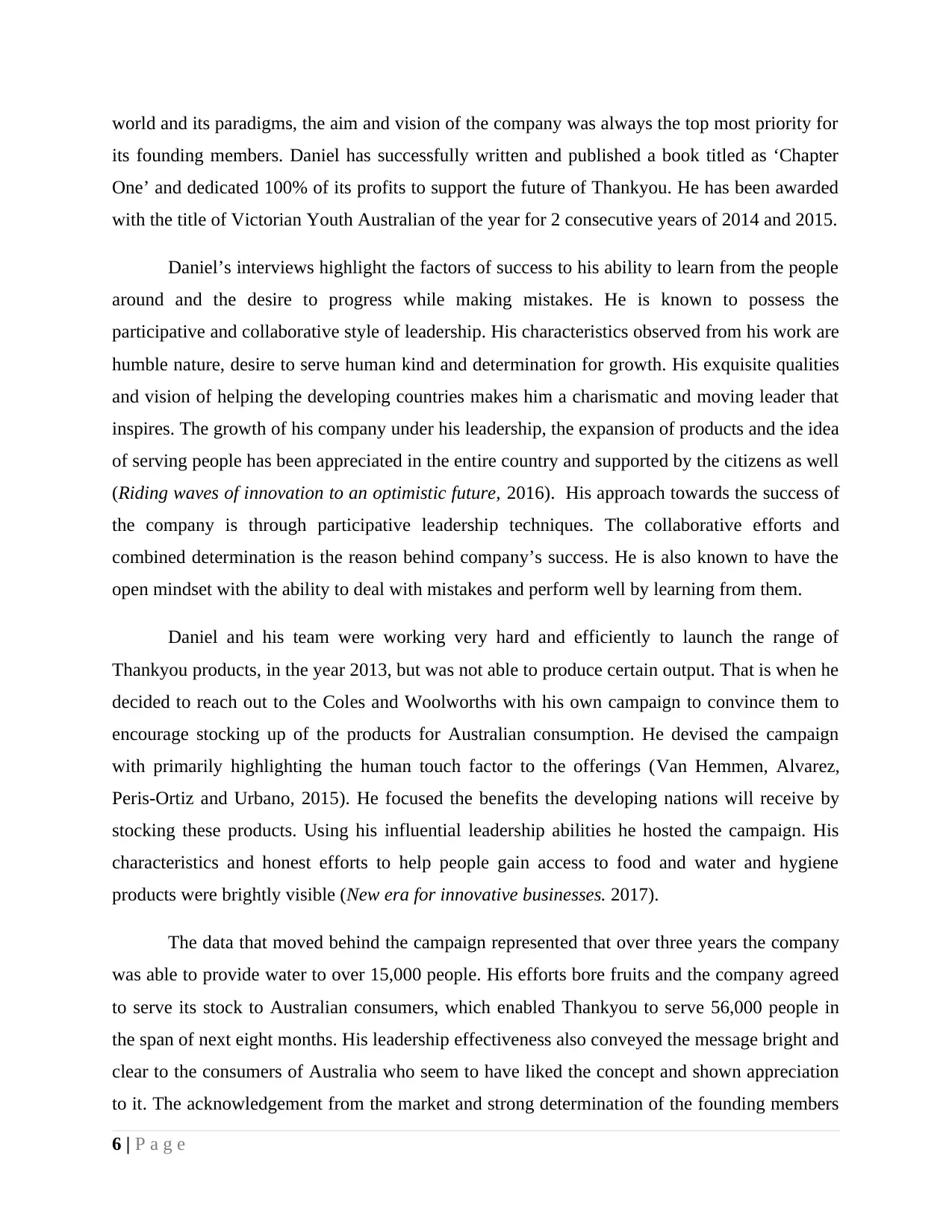
world and its paradigms, the aim and vision of the company was always the top most priority for
its founding members. Daniel has successfully written and published a book titled as ‘Chapter
One’ and dedicated 100% of its profits to support the future of Thankyou. He has been awarded
with the title of Victorian Youth Australian of the year for 2 consecutive years of 2014 and 2015.
Daniel’s interviews highlight the factors of success to his ability to learn from the people
around and the desire to progress while making mistakes. He is known to possess the
participative and collaborative style of leadership. His characteristics observed from his work are
humble nature, desire to serve human kind and determination for growth. His exquisite qualities
and vision of helping the developing countries makes him a charismatic and moving leader that
inspires. The growth of his company under his leadership, the expansion of products and the idea
of serving people has been appreciated in the entire country and supported by the citizens as well
(Riding waves of innovation to an optimistic future, 2016). His approach towards the success of
the company is through participative leadership techniques. The collaborative efforts and
combined determination is the reason behind company’s success. He is also known to have the
open mindset with the ability to deal with mistakes and perform well by learning from them.
Daniel and his team were working very hard and efficiently to launch the range of
Thankyou products, in the year 2013, but was not able to produce certain output. That is when he
decided to reach out to the Coles and Woolworths with his own campaign to convince them to
encourage stocking up of the products for Australian consumption. He devised the campaign
with primarily highlighting the human touch factor to the offerings (Van Hemmen, Alvarez,
Peris-Ortiz and Urbano, 2015). He focused the benefits the developing nations will receive by
stocking these products. Using his influential leadership abilities he hosted the campaign. His
characteristics and honest efforts to help people gain access to food and water and hygiene
products were brightly visible (New era for innovative businesses. 2017).
The data that moved behind the campaign represented that over three years the company
was able to provide water to over 15,000 people. His efforts bore fruits and the company agreed
to serve its stock to Australian consumers, which enabled Thankyou to serve 56,000 people in
the span of next eight months. His leadership effectiveness also conveyed the message bright and
clear to the consumers of Australia who seem to have liked the concept and shown appreciation
to it. The acknowledgement from the market and strong determination of the founding members
6 | P a g e
its founding members. Daniel has successfully written and published a book titled as ‘Chapter
One’ and dedicated 100% of its profits to support the future of Thankyou. He has been awarded
with the title of Victorian Youth Australian of the year for 2 consecutive years of 2014 and 2015.
Daniel’s interviews highlight the factors of success to his ability to learn from the people
around and the desire to progress while making mistakes. He is known to possess the
participative and collaborative style of leadership. His characteristics observed from his work are
humble nature, desire to serve human kind and determination for growth. His exquisite qualities
and vision of helping the developing countries makes him a charismatic and moving leader that
inspires. The growth of his company under his leadership, the expansion of products and the idea
of serving people has been appreciated in the entire country and supported by the citizens as well
(Riding waves of innovation to an optimistic future, 2016). His approach towards the success of
the company is through participative leadership techniques. The collaborative efforts and
combined determination is the reason behind company’s success. He is also known to have the
open mindset with the ability to deal with mistakes and perform well by learning from them.
Daniel and his team were working very hard and efficiently to launch the range of
Thankyou products, in the year 2013, but was not able to produce certain output. That is when he
decided to reach out to the Coles and Woolworths with his own campaign to convince them to
encourage stocking up of the products for Australian consumption. He devised the campaign
with primarily highlighting the human touch factor to the offerings (Van Hemmen, Alvarez,
Peris-Ortiz and Urbano, 2015). He focused the benefits the developing nations will receive by
stocking these products. Using his influential leadership abilities he hosted the campaign. His
characteristics and honest efforts to help people gain access to food and water and hygiene
products were brightly visible (New era for innovative businesses. 2017).
The data that moved behind the campaign represented that over three years the company
was able to provide water to over 15,000 people. His efforts bore fruits and the company agreed
to serve its stock to Australian consumers, which enabled Thankyou to serve 56,000 people in
the span of next eight months. His leadership effectiveness also conveyed the message bright and
clear to the consumers of Australia who seem to have liked the concept and shown appreciation
to it. The acknowledgement from the market and strong determination of the founding members
6 | P a g e
⊘ This is a preview!⊘
Do you want full access?
Subscribe today to unlock all pages.

Trusted by 1+ million students worldwide
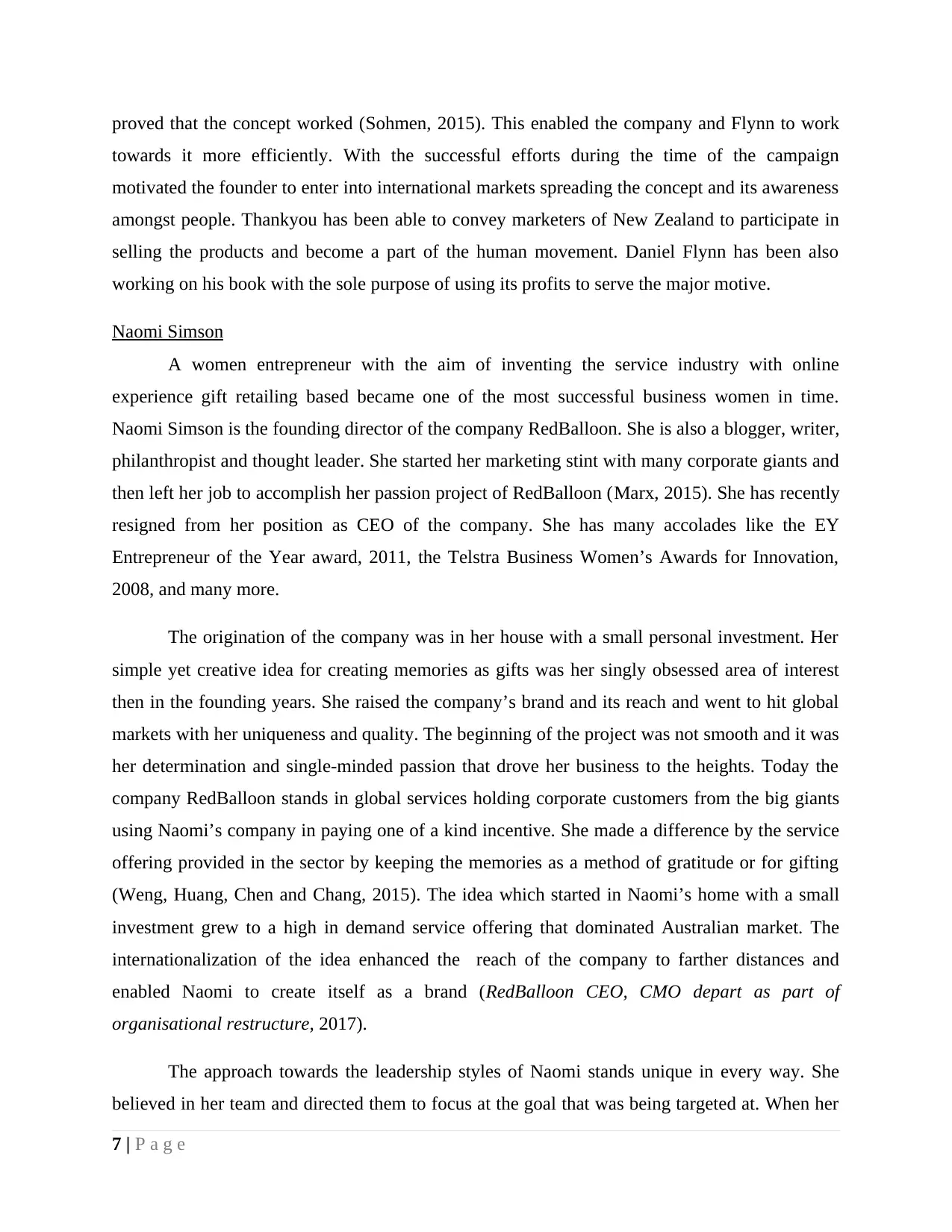
proved that the concept worked (Sohmen, 2015). This enabled the company and Flynn to work
towards it more efficiently. With the successful efforts during the time of the campaign
motivated the founder to enter into international markets spreading the concept and its awareness
amongst people. Thankyou has been able to convey marketers of New Zealand to participate in
selling the products and become a part of the human movement. Daniel Flynn has been also
working on his book with the sole purpose of using its profits to serve the major motive.
Naomi Simson
A women entrepreneur with the aim of inventing the service industry with online
experience gift retailing based became one of the most successful business women in time.
Naomi Simson is the founding director of the company RedBalloon. She is also a blogger, writer,
philanthropist and thought leader. She started her marketing stint with many corporate giants and
then left her job to accomplish her passion project of RedBalloon (Marx, 2015). She has recently
resigned from her position as CEO of the company. She has many accolades like the EY
Entrepreneur of the Year award, 2011, the Telstra Business Women’s Awards for Innovation,
2008, and many more.
The origination of the company was in her house with a small personal investment. Her
simple yet creative idea for creating memories as gifts was her singly obsessed area of interest
then in the founding years. She raised the company’s brand and its reach and went to hit global
markets with her uniqueness and quality. The beginning of the project was not smooth and it was
her determination and single-minded passion that drove her business to the heights. Today the
company RedBalloon stands in global services holding corporate customers from the big giants
using Naomi’s company in paying one of a kind incentive. She made a difference by the service
offering provided in the sector by keeping the memories as a method of gratitude or for gifting
(Weng, Huang, Chen and Chang, 2015). The idea which started in Naomi’s home with a small
investment grew to a high in demand service offering that dominated Australian market. The
internationalization of the idea enhanced the reach of the company to farther distances and
enabled Naomi to create itself as a brand (RedBalloon CEO, CMO depart as part of
organisational restructure, 2017).
The approach towards the leadership styles of Naomi stands unique in every way. She
believed in her team and directed them to focus at the goal that was being targeted at. When her
7 | P a g e
towards it more efficiently. With the successful efforts during the time of the campaign
motivated the founder to enter into international markets spreading the concept and its awareness
amongst people. Thankyou has been able to convey marketers of New Zealand to participate in
selling the products and become a part of the human movement. Daniel Flynn has been also
working on his book with the sole purpose of using its profits to serve the major motive.
Naomi Simson
A women entrepreneur with the aim of inventing the service industry with online
experience gift retailing based became one of the most successful business women in time.
Naomi Simson is the founding director of the company RedBalloon. She is also a blogger, writer,
philanthropist and thought leader. She started her marketing stint with many corporate giants and
then left her job to accomplish her passion project of RedBalloon (Marx, 2015). She has recently
resigned from her position as CEO of the company. She has many accolades like the EY
Entrepreneur of the Year award, 2011, the Telstra Business Women’s Awards for Innovation,
2008, and many more.
The origination of the company was in her house with a small personal investment. Her
simple yet creative idea for creating memories as gifts was her singly obsessed area of interest
then in the founding years. She raised the company’s brand and its reach and went to hit global
markets with her uniqueness and quality. The beginning of the project was not smooth and it was
her determination and single-minded passion that drove her business to the heights. Today the
company RedBalloon stands in global services holding corporate customers from the big giants
using Naomi’s company in paying one of a kind incentive. She made a difference by the service
offering provided in the sector by keeping the memories as a method of gratitude or for gifting
(Weng, Huang, Chen and Chang, 2015). The idea which started in Naomi’s home with a small
investment grew to a high in demand service offering that dominated Australian market. The
internationalization of the idea enhanced the reach of the company to farther distances and
enabled Naomi to create itself as a brand (RedBalloon CEO, CMO depart as part of
organisational restructure, 2017).
The approach towards the leadership styles of Naomi stands unique in every way. She
believed in her team and directed them to focus at the goal that was being targeted at. When her
7 | P a g e
Paraphrase This Document
Need a fresh take? Get an instant paraphrase of this document with our AI Paraphraser
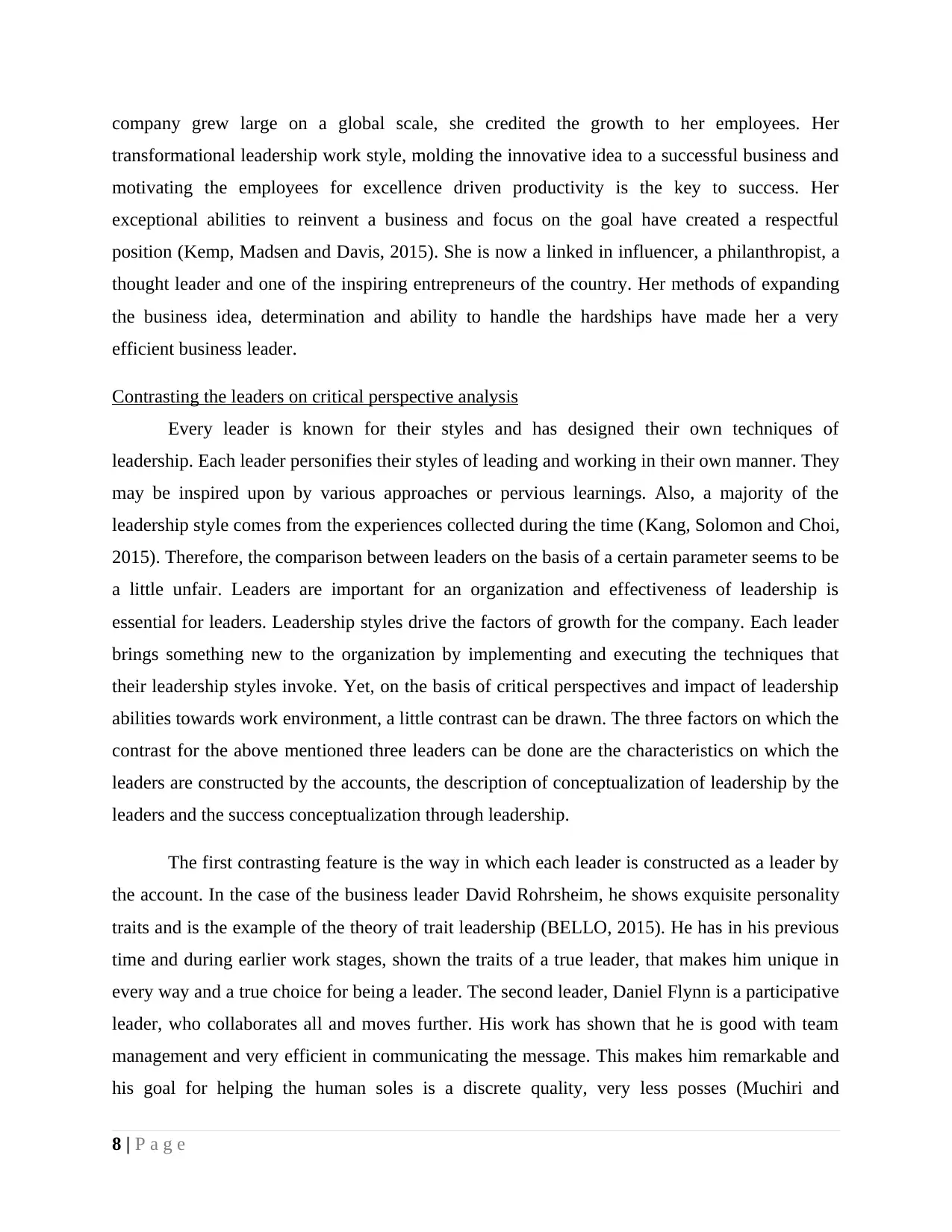
company grew large on a global scale, she credited the growth to her employees. Her
transformational leadership work style, molding the innovative idea to a successful business and
motivating the employees for excellence driven productivity is the key to success. Her
exceptional abilities to reinvent a business and focus on the goal have created a respectful
position (Kemp, Madsen and Davis, 2015). She is now a linked in influencer, a philanthropist, a
thought leader and one of the inspiring entrepreneurs of the country. Her methods of expanding
the business idea, determination and ability to handle the hardships have made her a very
efficient business leader.
Contrasting the leaders on critical perspective analysis
Every leader is known for their styles and has designed their own techniques of
leadership. Each leader personifies their styles of leading and working in their own manner. They
may be inspired upon by various approaches or pervious learnings. Also, a majority of the
leadership style comes from the experiences collected during the time (Kang, Solomon and Choi,
2015). Therefore, the comparison between leaders on the basis of a certain parameter seems to be
a little unfair. Leaders are important for an organization and effectiveness of leadership is
essential for leaders. Leadership styles drive the factors of growth for the company. Each leader
brings something new to the organization by implementing and executing the techniques that
their leadership styles invoke. Yet, on the basis of critical perspectives and impact of leadership
abilities towards work environment, a little contrast can be drawn. The three factors on which the
contrast for the above mentioned three leaders can be done are the characteristics on which the
leaders are constructed by the accounts, the description of conceptualization of leadership by the
leaders and the success conceptualization through leadership.
The first contrasting feature is the way in which each leader is constructed as a leader by
the account. In the case of the business leader David Rohrsheim, he shows exquisite personality
traits and is the example of the theory of trait leadership (BELLO, 2015). He has in his previous
time and during earlier work stages, shown the traits of a true leader, that makes him unique in
every way and a true choice for being a leader. The second leader, Daniel Flynn is a participative
leader, who collaborates all and moves further. His work has shown that he is good with team
management and very efficient in communicating the message. This makes him remarkable and
his goal for helping the human soles is a discrete quality, very less posses (Muchiri and
8 | P a g e
transformational leadership work style, molding the innovative idea to a successful business and
motivating the employees for excellence driven productivity is the key to success. Her
exceptional abilities to reinvent a business and focus on the goal have created a respectful
position (Kemp, Madsen and Davis, 2015). She is now a linked in influencer, a philanthropist, a
thought leader and one of the inspiring entrepreneurs of the country. Her methods of expanding
the business idea, determination and ability to handle the hardships have made her a very
efficient business leader.
Contrasting the leaders on critical perspective analysis
Every leader is known for their styles and has designed their own techniques of
leadership. Each leader personifies their styles of leading and working in their own manner. They
may be inspired upon by various approaches or pervious learnings. Also, a majority of the
leadership style comes from the experiences collected during the time (Kang, Solomon and Choi,
2015). Therefore, the comparison between leaders on the basis of a certain parameter seems to be
a little unfair. Leaders are important for an organization and effectiveness of leadership is
essential for leaders. Leadership styles drive the factors of growth for the company. Each leader
brings something new to the organization by implementing and executing the techniques that
their leadership styles invoke. Yet, on the basis of critical perspectives and impact of leadership
abilities towards work environment, a little contrast can be drawn. The three factors on which the
contrast for the above mentioned three leaders can be done are the characteristics on which the
leaders are constructed by the accounts, the description of conceptualization of leadership by the
leaders and the success conceptualization through leadership.
The first contrasting feature is the way in which each leader is constructed as a leader by
the account. In the case of the business leader David Rohrsheim, he shows exquisite personality
traits and is the example of the theory of trait leadership (BELLO, 2015). He has in his previous
time and during earlier work stages, shown the traits of a true leader, that makes him unique in
every way and a true choice for being a leader. The second leader, Daniel Flynn is a participative
leader, who collaborates all and moves further. His work has shown that he is good with team
management and very efficient in communicating the message. This makes him remarkable and
his goal for helping the human soles is a discrete quality, very less posses (Muchiri and
8 | P a g e
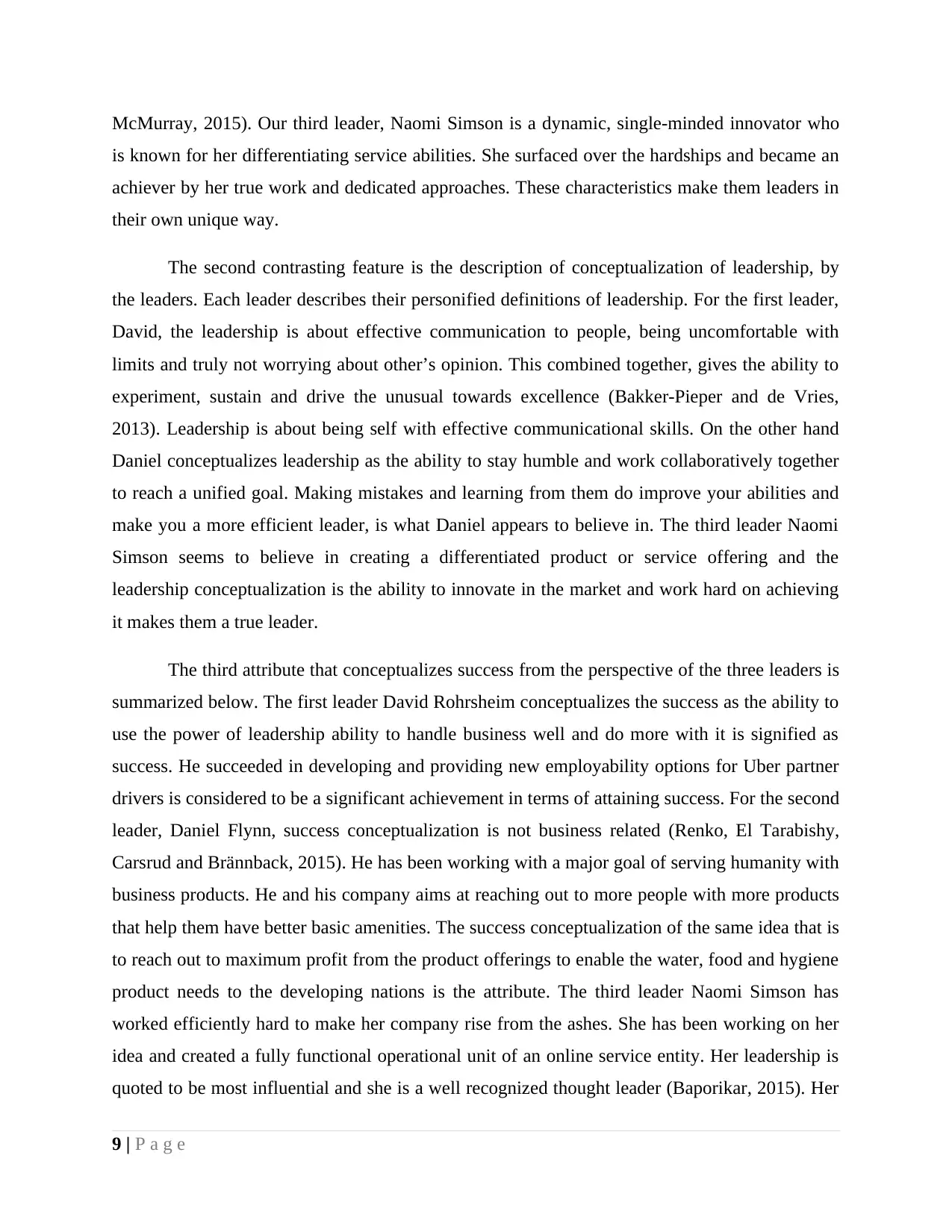
McMurray, 2015). Our third leader, Naomi Simson is a dynamic, single-minded innovator who
is known for her differentiating service abilities. She surfaced over the hardships and became an
achiever by her true work and dedicated approaches. These characteristics make them leaders in
their own unique way.
The second contrasting feature is the description of conceptualization of leadership, by
the leaders. Each leader describes their personified definitions of leadership. For the first leader,
David, the leadership is about effective communication to people, being uncomfortable with
limits and truly not worrying about other’s opinion. This combined together, gives the ability to
experiment, sustain and drive the unusual towards excellence (Bakker-Pieper and de Vries,
2013). Leadership is about being self with effective communicational skills. On the other hand
Daniel conceptualizes leadership as the ability to stay humble and work collaboratively together
to reach a unified goal. Making mistakes and learning from them do improve your abilities and
make you a more efficient leader, is what Daniel appears to believe in. The third leader Naomi
Simson seems to believe in creating a differentiated product or service offering and the
leadership conceptualization is the ability to innovate in the market and work hard on achieving
it makes them a true leader.
The third attribute that conceptualizes success from the perspective of the three leaders is
summarized below. The first leader David Rohrsheim conceptualizes the success as the ability to
use the power of leadership ability to handle business well and do more with it is signified as
success. He succeeded in developing and providing new employability options for Uber partner
drivers is considered to be a significant achievement in terms of attaining success. For the second
leader, Daniel Flynn, success conceptualization is not business related (Renko, El Tarabishy,
Carsrud and Brännback, 2015). He has been working with a major goal of serving humanity with
business products. He and his company aims at reaching out to more people with more products
that help them have better basic amenities. The success conceptualization of the same idea that is
to reach out to maximum profit from the product offerings to enable the water, food and hygiene
product needs to the developing nations is the attribute. The third leader Naomi Simson has
worked efficiently hard to make her company rise from the ashes. She has been working on her
idea and created a fully functional operational unit of an online service entity. Her leadership is
quoted to be most influential and she is a well recognized thought leader (Baporikar, 2015). Her
9 | P a g e
is known for her differentiating service abilities. She surfaced over the hardships and became an
achiever by her true work and dedicated approaches. These characteristics make them leaders in
their own unique way.
The second contrasting feature is the description of conceptualization of leadership, by
the leaders. Each leader describes their personified definitions of leadership. For the first leader,
David, the leadership is about effective communication to people, being uncomfortable with
limits and truly not worrying about other’s opinion. This combined together, gives the ability to
experiment, sustain and drive the unusual towards excellence (Bakker-Pieper and de Vries,
2013). Leadership is about being self with effective communicational skills. On the other hand
Daniel conceptualizes leadership as the ability to stay humble and work collaboratively together
to reach a unified goal. Making mistakes and learning from them do improve your abilities and
make you a more efficient leader, is what Daniel appears to believe in. The third leader Naomi
Simson seems to believe in creating a differentiated product or service offering and the
leadership conceptualization is the ability to innovate in the market and work hard on achieving
it makes them a true leader.
The third attribute that conceptualizes success from the perspective of the three leaders is
summarized below. The first leader David Rohrsheim conceptualizes the success as the ability to
use the power of leadership ability to handle business well and do more with it is signified as
success. He succeeded in developing and providing new employability options for Uber partner
drivers is considered to be a significant achievement in terms of attaining success. For the second
leader, Daniel Flynn, success conceptualization is not business related (Renko, El Tarabishy,
Carsrud and Brännback, 2015). He has been working with a major goal of serving humanity with
business products. He and his company aims at reaching out to more people with more products
that help them have better basic amenities. The success conceptualization of the same idea that is
to reach out to maximum profit from the product offerings to enable the water, food and hygiene
product needs to the developing nations is the attribute. The third leader Naomi Simson has
worked efficiently hard to make her company rise from the ashes. She has been working on her
idea and created a fully functional operational unit of an online service entity. Her leadership is
quoted to be most influential and she is a well recognized thought leader (Baporikar, 2015). Her
9 | P a g e
⊘ This is a preview!⊘
Do you want full access?
Subscribe today to unlock all pages.

Trusted by 1+ million students worldwide
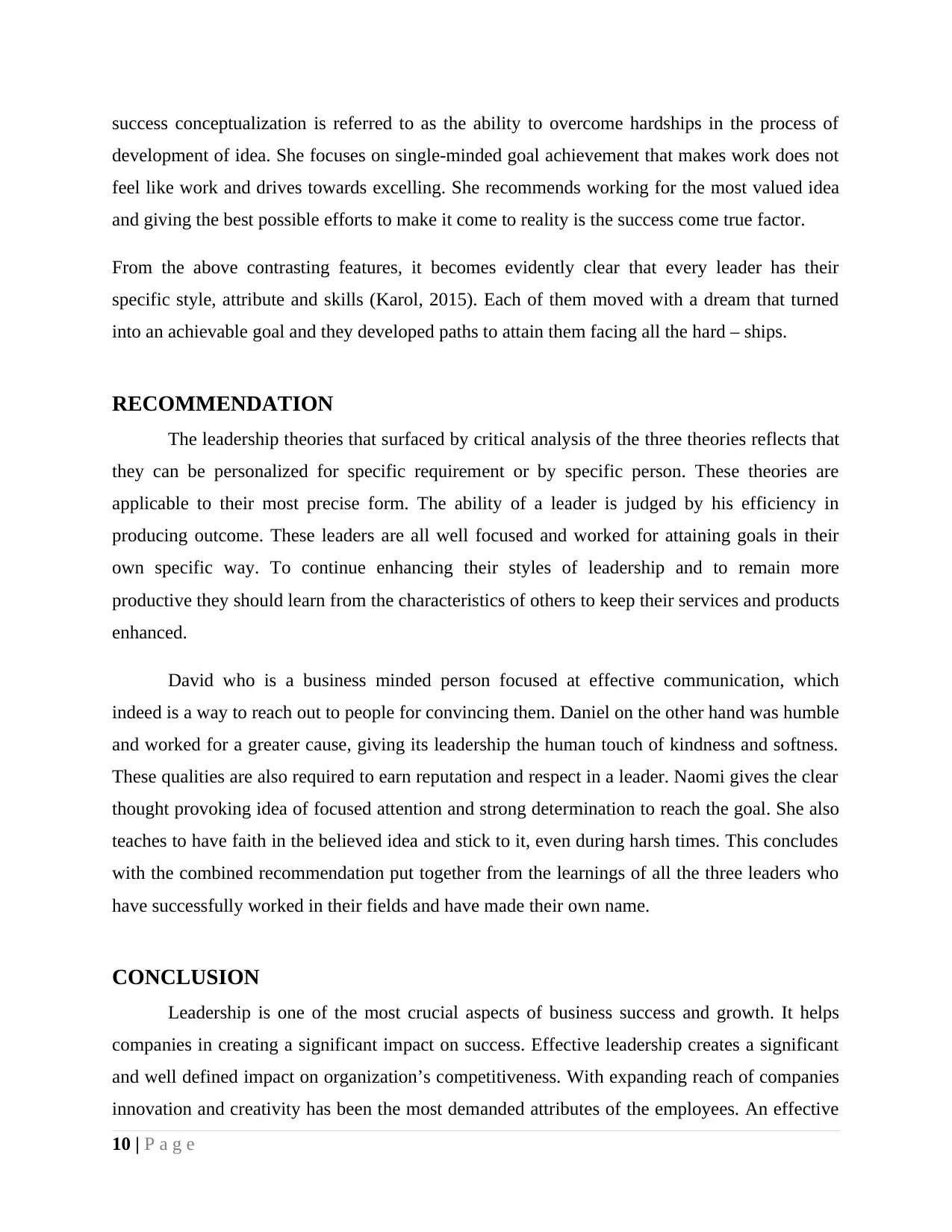
success conceptualization is referred to as the ability to overcome hardships in the process of
development of idea. She focuses on single-minded goal achievement that makes work does not
feel like work and drives towards excelling. She recommends working for the most valued idea
and giving the best possible efforts to make it come to reality is the success come true factor.
From the above contrasting features, it becomes evidently clear that every leader has their
specific style, attribute and skills (Karol, 2015). Each of them moved with a dream that turned
into an achievable goal and they developed paths to attain them facing all the hard – ships.
RECOMMENDATION
The leadership theories that surfaced by critical analysis of the three theories reflects that
they can be personalized for specific requirement or by specific person. These theories are
applicable to their most precise form. The ability of a leader is judged by his efficiency in
producing outcome. These leaders are all well focused and worked for attaining goals in their
own specific way. To continue enhancing their styles of leadership and to remain more
productive they should learn from the characteristics of others to keep their services and products
enhanced.
David who is a business minded person focused at effective communication, which
indeed is a way to reach out to people for convincing them. Daniel on the other hand was humble
and worked for a greater cause, giving its leadership the human touch of kindness and softness.
These qualities are also required to earn reputation and respect in a leader. Naomi gives the clear
thought provoking idea of focused attention and strong determination to reach the goal. She also
teaches to have faith in the believed idea and stick to it, even during harsh times. This concludes
with the combined recommendation put together from the learnings of all the three leaders who
have successfully worked in their fields and have made their own name.
CONCLUSION
Leadership is one of the most crucial aspects of business success and growth. It helps
companies in creating a significant impact on success. Effective leadership creates a significant
and well defined impact on organization’s competitiveness. With expanding reach of companies
innovation and creativity has been the most demanded attributes of the employees. An effective
10 | P a g e
development of idea. She focuses on single-minded goal achievement that makes work does not
feel like work and drives towards excelling. She recommends working for the most valued idea
and giving the best possible efforts to make it come to reality is the success come true factor.
From the above contrasting features, it becomes evidently clear that every leader has their
specific style, attribute and skills (Karol, 2015). Each of them moved with a dream that turned
into an achievable goal and they developed paths to attain them facing all the hard – ships.
RECOMMENDATION
The leadership theories that surfaced by critical analysis of the three theories reflects that
they can be personalized for specific requirement or by specific person. These theories are
applicable to their most precise form. The ability of a leader is judged by his efficiency in
producing outcome. These leaders are all well focused and worked for attaining goals in their
own specific way. To continue enhancing their styles of leadership and to remain more
productive they should learn from the characteristics of others to keep their services and products
enhanced.
David who is a business minded person focused at effective communication, which
indeed is a way to reach out to people for convincing them. Daniel on the other hand was humble
and worked for a greater cause, giving its leadership the human touch of kindness and softness.
These qualities are also required to earn reputation and respect in a leader. Naomi gives the clear
thought provoking idea of focused attention and strong determination to reach the goal. She also
teaches to have faith in the believed idea and stick to it, even during harsh times. This concludes
with the combined recommendation put together from the learnings of all the three leaders who
have successfully worked in their fields and have made their own name.
CONCLUSION
Leadership is one of the most crucial aspects of business success and growth. It helps
companies in creating a significant impact on success. Effective leadership creates a significant
and well defined impact on organization’s competitiveness. With expanding reach of companies
innovation and creativity has been the most demanded attributes of the employees. An effective
10 | P a g e
Paraphrase This Document
Need a fresh take? Get an instant paraphrase of this document with our AI Paraphraser
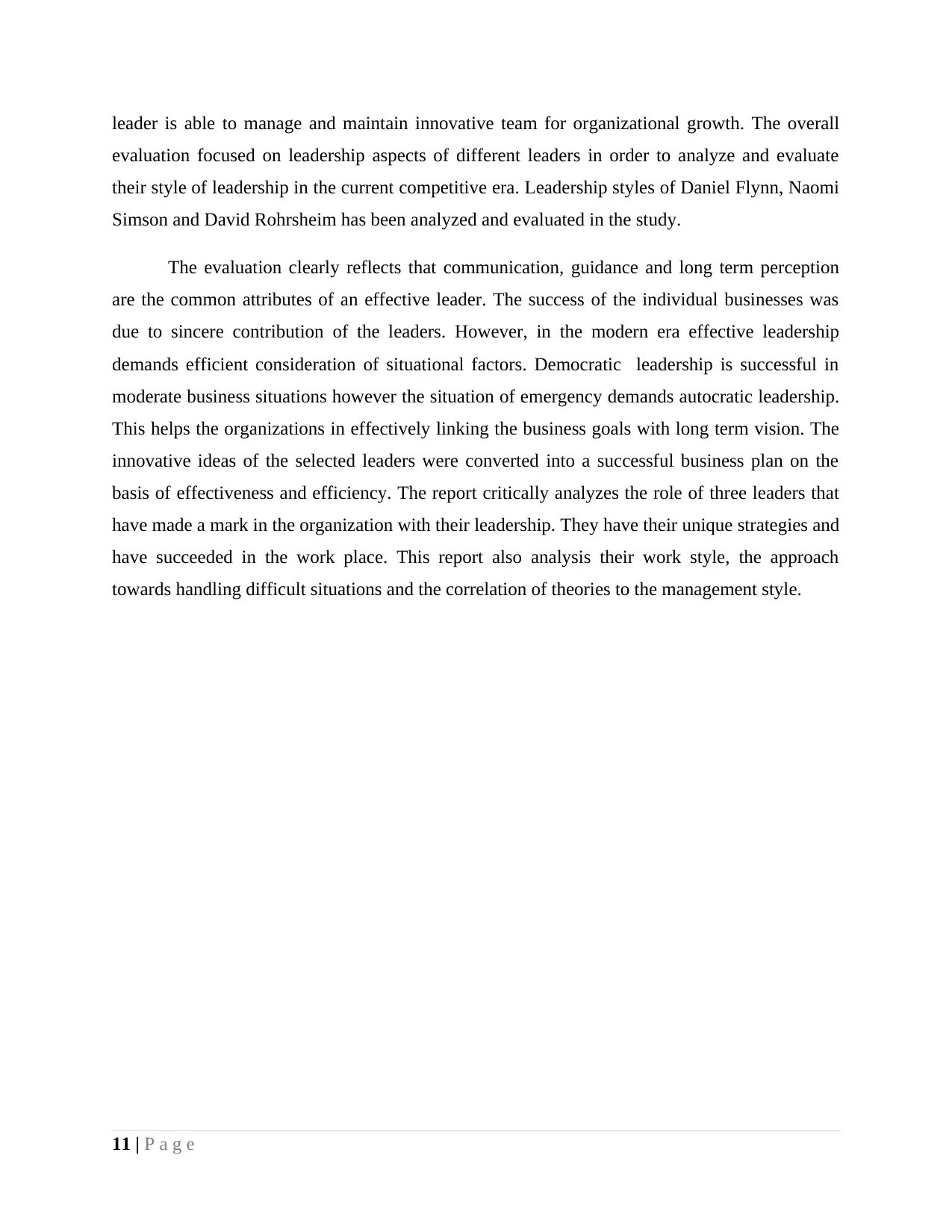
leader is able to manage and maintain innovative team for organizational growth. The overall
evaluation focused on leadership aspects of different leaders in order to analyze and evaluate
their style of leadership in the current competitive era. Leadership styles of Daniel Flynn, Naomi
Simson and David Rohrsheim has been analyzed and evaluated in the study.
The evaluation clearly reflects that communication, guidance and long term perception
are the common attributes of an effective leader. The success of the individual businesses was
due to sincere contribution of the leaders. However, in the modern era effective leadership
demands efficient consideration of situational factors. Democratic leadership is successful in
moderate business situations however the situation of emergency demands autocratic leadership.
This helps the organizations in effectively linking the business goals with long term vision. The
innovative ideas of the selected leaders were converted into a successful business plan on the
basis of effectiveness and efficiency. The report critically analyzes the role of three leaders that
have made a mark in the organization with their leadership. They have their unique strategies and
have succeeded in the work place. This report also analysis their work style, the approach
towards handling difficult situations and the correlation of theories to the management style.
11 | P a g e
evaluation focused on leadership aspects of different leaders in order to analyze and evaluate
their style of leadership in the current competitive era. Leadership styles of Daniel Flynn, Naomi
Simson and David Rohrsheim has been analyzed and evaluated in the study.
The evaluation clearly reflects that communication, guidance and long term perception
are the common attributes of an effective leader. The success of the individual businesses was
due to sincere contribution of the leaders. However, in the modern era effective leadership
demands efficient consideration of situational factors. Democratic leadership is successful in
moderate business situations however the situation of emergency demands autocratic leadership.
This helps the organizations in effectively linking the business goals with long term vision. The
innovative ideas of the selected leaders were converted into a successful business plan on the
basis of effectiveness and efficiency. The report critically analyzes the role of three leaders that
have made a mark in the organization with their leadership. They have their unique strategies and
have succeeded in the work place. This report also analysis their work style, the approach
towards handling difficult situations and the correlation of theories to the management style.
11 | P a g e
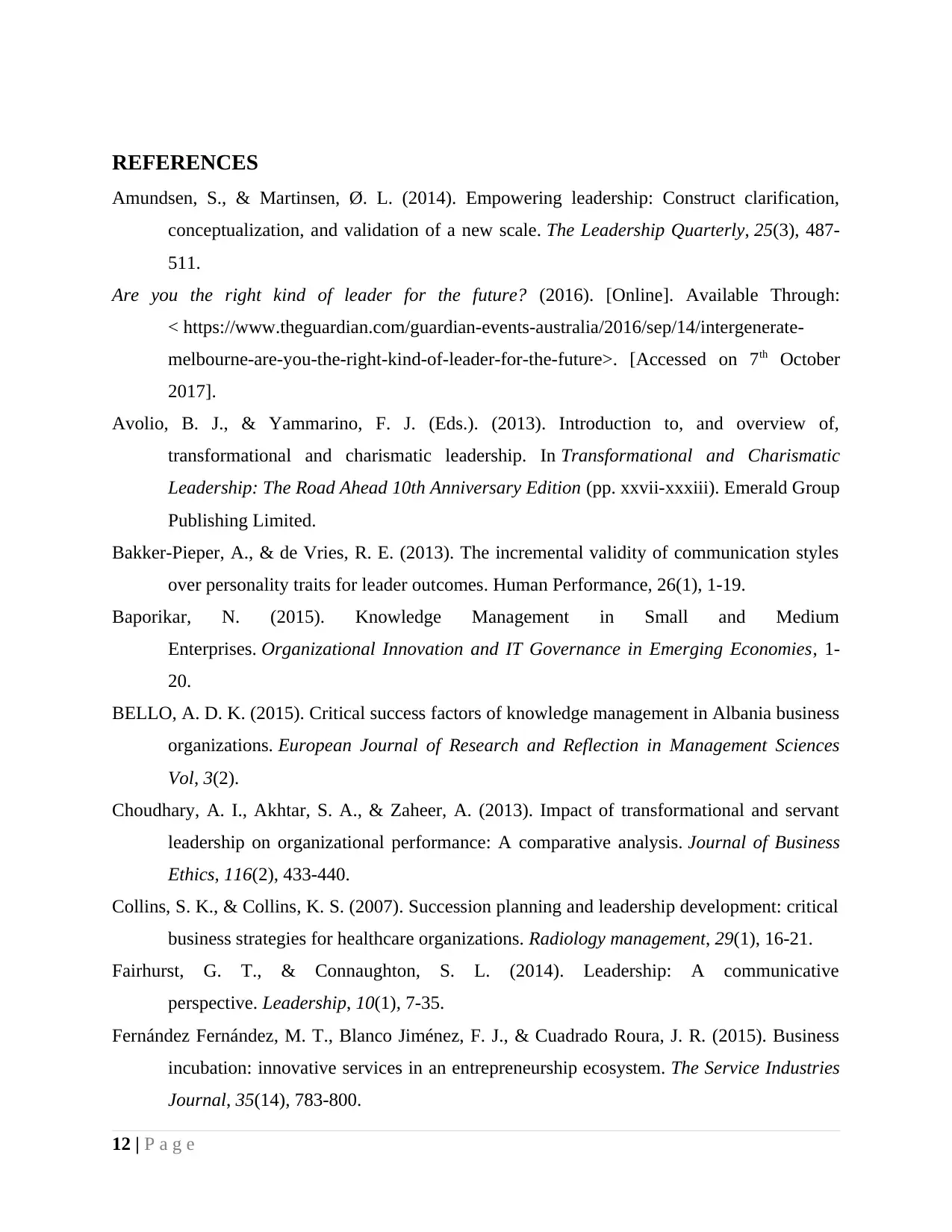
REFERENCES
Amundsen, S., & Martinsen, Ø. L. (2014). Empowering leadership: Construct clarification,
conceptualization, and validation of a new scale. The Leadership Quarterly, 25(3), 487-
511.
Are you the right kind of leader for the future? (2016). [Online]. Available Through:
< https://www.theguardian.com/guardian-events-australia/2016/sep/14/intergenerate-
melbourne-are-you-the-right-kind-of-leader-for-the-future>. [Accessed on 7th October
2017].
Avolio, B. J., & Yammarino, F. J. (Eds.). (2013). Introduction to, and overview of,
transformational and charismatic leadership. In Transformational and Charismatic
Leadership: The Road Ahead 10th Anniversary Edition (pp. xxvii-xxxiii). Emerald Group
Publishing Limited.
Bakker-Pieper, A., & de Vries, R. E. (2013). The incremental validity of communication styles
over personality traits for leader outcomes. Human Performance, 26(1), 1-19.
Baporikar, N. (2015). Knowledge Management in Small and Medium
Enterprises. Organizational Innovation and IT Governance in Emerging Economies, 1-
20.
BELLO, A. D. K. (2015). Critical success factors of knowledge management in Albania business
organizations. European Journal of Research and Reflection in Management Sciences
Vol, 3(2).
Choudhary, A. I., Akhtar, S. A., & Zaheer, A. (2013). Impact of transformational and servant
leadership on organizational performance: A comparative analysis. Journal of Business
Ethics, 116(2), 433-440.
Collins, S. K., & Collins, K. S. (2007). Succession planning and leadership development: critical
business strategies for healthcare organizations. Radiology management, 29(1), 16-21.
Fairhurst, G. T., & Connaughton, S. L. (2014). Leadership: A communicative
perspective. Leadership, 10(1), 7-35.
Fernández Fernández, M. T., Blanco Jiménez, F. J., & Cuadrado Roura, J. R. (2015). Business
incubation: innovative services in an entrepreneurship ecosystem. The Service Industries
Journal, 35(14), 783-800.
12 | P a g e
Amundsen, S., & Martinsen, Ø. L. (2014). Empowering leadership: Construct clarification,
conceptualization, and validation of a new scale. The Leadership Quarterly, 25(3), 487-
511.
Are you the right kind of leader for the future? (2016). [Online]. Available Through:
< https://www.theguardian.com/guardian-events-australia/2016/sep/14/intergenerate-
melbourne-are-you-the-right-kind-of-leader-for-the-future>. [Accessed on 7th October
2017].
Avolio, B. J., & Yammarino, F. J. (Eds.). (2013). Introduction to, and overview of,
transformational and charismatic leadership. In Transformational and Charismatic
Leadership: The Road Ahead 10th Anniversary Edition (pp. xxvii-xxxiii). Emerald Group
Publishing Limited.
Bakker-Pieper, A., & de Vries, R. E. (2013). The incremental validity of communication styles
over personality traits for leader outcomes. Human Performance, 26(1), 1-19.
Baporikar, N. (2015). Knowledge Management in Small and Medium
Enterprises. Organizational Innovation and IT Governance in Emerging Economies, 1-
20.
BELLO, A. D. K. (2015). Critical success factors of knowledge management in Albania business
organizations. European Journal of Research and Reflection in Management Sciences
Vol, 3(2).
Choudhary, A. I., Akhtar, S. A., & Zaheer, A. (2013). Impact of transformational and servant
leadership on organizational performance: A comparative analysis. Journal of Business
Ethics, 116(2), 433-440.
Collins, S. K., & Collins, K. S. (2007). Succession planning and leadership development: critical
business strategies for healthcare organizations. Radiology management, 29(1), 16-21.
Fairhurst, G. T., & Connaughton, S. L. (2014). Leadership: A communicative
perspective. Leadership, 10(1), 7-35.
Fernández Fernández, M. T., Blanco Jiménez, F. J., & Cuadrado Roura, J. R. (2015). Business
incubation: innovative services in an entrepreneurship ecosystem. The Service Industries
Journal, 35(14), 783-800.
12 | P a g e
⊘ This is a preview!⊘
Do you want full access?
Subscribe today to unlock all pages.

Trusted by 1+ million students worldwide
1 out of 14
Related Documents
Your All-in-One AI-Powered Toolkit for Academic Success.
+13062052269
info@desklib.com
Available 24*7 on WhatsApp / Email
![[object Object]](/_next/static/media/star-bottom.7253800d.svg)
Unlock your academic potential
Copyright © 2020–2025 A2Z Services. All Rights Reserved. Developed and managed by ZUCOL.



